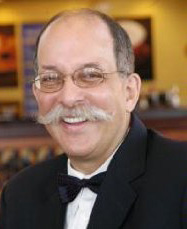
The Modern Butlers’ Journal volume 8, issue 3
International Institute of Modern Butlers
 Message from the Chairman
Message from the Chairman
Copying, copyright, and doing the right thing

You may have noticed the MBJ has a new look—fewer photographs. This is the result of a rather heavy handed enforcement of copyrights by lawyers trolling the Web for improper usage. We had inadvertently used one image that we had thought had been in the public domain. We have no issue with enforcement of copyright—we have, after all, seen such copying of our own material as the entire web site, down to font, color, and commas, by some outfit out of China. It took persistence to have it removed.
More common is the usage of our concepts and text by others in our industry. The most recent example was brought to our attention a couple of days ago, when an affiliate in the Far East asked us to confirm that a training outline from a web site was correct. In checking, we found that this site had copied verbatim from another site, which, in turn, had copied verbatim from our site.
I have brought this up in an earlier Journal: if an individual is so short of ideas and original thought that he or she has to copy the work of others and hide their source, they could at least put some effort into it and use their own words. Simply cutting and pasting betrays a lack of effort and understanding that would neither serve nor impress potential buyers of their services. Those clients won’t know until the copycat arrives on their doorstep and fails to deliver the expected level of service. Then, over time, word spreads and the individual goes out of business. Maybe these people should quit while they are ahead, instead of leaving upset clients in their wake and muddying up the industry.
Along the same line, I need to beat another drum about a similar “quicky impulse” that is degrading our profession. As we have just posted on our home page, our consulting and training rates are the highest in the industry for the simple reason that we believe five-star standards are best served by five-star training. This does not mean exorbitant rates, but it does mean that when we write proposals, they are designed to bring about well-trained butlers who are a credit to their employers. We are happy to bid on, and participate in, projects where this is the understanding and the goal. However, we cannot endorse training of butlers in a day or two just so a certificate can be issued—the butlers know when they have been trained properly, as do their employers and guests. The simple truth is, it is well-trained butlers, not certificates, that provide superior service.
To the majority who understand that the butler profession is principally about quality, not superficial appearances, thank you!
Letters to the Editor

I have some reservations about the article in The Guardian that was mentioned in the last MBJ and signed by an unknown ‘Stevens’—a reason to suspect that the article may not be genuine. What is more suspicious is that this reported colleague confuses the duties of a butler with those of a valet and personal assistant. It is true that sometime the three roles can be combined into a wider butler role, but the butler is inevitably attached to an employer’s property, today as in the past, and yet Stevens travels around the whole time with his employer. Stevens concludes that his job ‘hasn’t changed much since the 19th-century, other than the fact I carry two Blackberrys instead of tails.’ The reality is indeed that the job has not changed at all if we talk about the mindset and the tradition: The key difference is probably in the complexity and size of the properties and the number of members of staff we are today called to manage, which has decreased over the last century.” G.L.
Editor Note: Thank you for your observations and thoughts. We are happy to take Stevens at face value—his misnomer could perhaps be ascribed to his lack of formal training, having switched to the profession (obviously quite successfully) from acting.
Butlers in the Media
The White House Butler
Eugene Allen, the butler who worked at the White House in Washington DC under eight presidents from 1952 to 1986, will have his life immortalized in a planned film aptly called The Butler by director Lee Daniels. Oprah Winfrey is in talks about playing the role of Mrs. Allen. The source for the film appears to be Wil Haygood’s A Butler Well Served by This Election, a story published in a Washington Post edition during 2008. Hopefully, the source will be augmented by enough material for an accurate portrayal. Lee Daniels seems to specialize in macabre movies (The Paperboy and The Precious), so hopefully this one will be a break from his norm.
The Secret Appeal of Downton Abbey
In an article entitled The Secret Appeal of Downton Abbey, the Wall Street Journal explains the popularity of Downton Abbey in the United States as being based on a voyeurism or “pornography of class and hierarchy.” Points good and bad are made, the worst assumption being that happiness depends upon wealth; the worst assertion being that we are all snobs; and the best insight (wonderfully phrased) being, “Downton Abbey portrays a fairy-tale way of life in which butlers and footmen appear far better dressed than today’s billionaires—many of whom, after making their fortune, seem to want to be sartorially indistinguishable from the most sloppily dressed adolescent rebel. The series thus satisfies a secret or vicarious longing for elegance without imposing the hard work that’s necessary to achieve it in reality.”
Placement
Upbeat Household Manager required for family in large estate in Miami. Must speak Spanish to manage the large number of staff.
A PA/Valet for high-profile individual traveling extensively between London, New York, Kuwait, and his yacht.
Email us if you are interested and feel you might qualify.
Cigars, Part II
Growing Tobacco
It is believed that tobacco may have been cultivated in the Americas as far back as 6,000BC. These days Brazil, China, USA, Turkey and India produce about 2/3rds of the world’s tobacco. Our focus for this instalment will be Cuba, as we are interested in tobacco grown for use in premium cigars, rather than the mass agriculture of cigarette tobacco.
At one point, Greece was the only country in the world dedicating more land to tobacco cultivation than Cuba. This is extraordinary if one considers that Cuba is about the size of Pennsylvania. While Cuba is not ranked in the top ten producers by yield, it certainly is considered one of the best in terms of quality. Both the lower production figures and the high quality of Cuban tobacco may be attributed partly to their use of traditional labour-intensive farming methods. In addition, the climate and soil in certain parts of this country seem almost uniquely suited to growing this crop.
85% of tobacco grown in Cuba is produced by small-scale farmers belonging to the National Association of Small Farmers. Such farmers are historically more productive than the state-owned cooperatives, producing a leaf yield of up to 80% per plant while some state-owned farms manage only 10-20%. For some years now, the Cuban government has been returning land to small farmers in the interests of both higher yields and quality.
The premier tobacco growing regions in Cuba are; Oriente, Remedios, Partidos, Semi-Vuelta, and Vuelta Abajo, with the Vuelta Abajo region generally being regarded as the finest.
Tobacco is part of the nightshade family of plants (Solanaceae), of the genus Nicotiana. There are many types of tobacco, but Cuba mostly grows varieties of Criollo and Corojo. Criollo is considered one of the original Cuban

tobaccos and can be traced back to the time of Columbus. Corojo on the other hand dates back to the 1930’s and was originally used as wrapper leaf, relegating the Criollo leaves to the inside of the cigar. Subsequently, it was found that if Criollo is given the proper care and grown in the shade, it too can make a good wrapper leaf. In the 1990’s Corojo was replaced with a less delicate hybrid, Habana 2000. These days Cuba mostly plants two hybrid strains, Criollo ‘98 which is Blue Mould resistant and Corojo ’99.
The seeds are as fine as ground pepper and are sowed on top of the soil as they need sunlight to germinate. In some countries the seedlings must to be protected from frost by germinating them under glass in the early spring. In warmer climates it is only necessary to cover them with thin cloth to protect them from beetles. Once the seedling is around 8 inches tall, it will be planted out in the fields and may still be grown under muslin tents if shade-grown wrapper leaves are required.
Tobacco is an annual crop and if the planting is done by hand, it will be done after the rain so that the seedlings can be planted in moist soil. This is not necessary when using an automated planting machine, as it waters the hole it makes before planting the seedling.
The plants remain susceptible to water stress and need to be kept in well-drained, moist soil. Tobacco fields are also usually well tended as the plants do not like competing with weeds for water.
Tobacco growers traditionally spoke of the magic sixes – six weeks to germinate, six weeks to grow, six weeks to harvest, six weeks to cure and six weeks to ferment. Obviously the actual timing can be affected by many factors, but the ‘magic sixes’ remain a valid, if somewhat coarse guideline. Unless a farmer wants to collect seed, the plants will be topped as soon as they start forming flowers. This allows the upper leaves to grow larger and thicker than they would otherwise. Soon after topping, axillary buds will begin forming and these buds, called suckers, must also be removed otherwise they will reduce the quality of the tobacco leaf.
Next month we will discuss the harvest, as this is done in stages, different leaves being put to different use.
Click on http://www.businessinsider.com/cuba-tobacco-farm-2011-9 to see some beautiful pictures of tobacco farming in Cuba taken over a ten-year period by photographer John Valls.
Let’s Talk about Wine, Part IV
 by Amer Vargas
by Amer Vargas

After the must has undergone the desired fermentation and/or maceration, the drink is ready for the next step, called stabilization, in which the tank is emptied through a large strainer into a container so as to separate the liquid
from the skins and pips. This wine is then transferred into iron or concrete tanks, or wooden barrels where it becomes the best quality wine (compared to lesser-quality wine obtained by pressing the skins and pips again).
At this stage, the wine is allowed to go through malolactic fermentation (as explained in last article) if desired, to have lighter and fresher wines, reducing its acidity and giving more complexity.
From cloudy alcoholic juice to pre-wine
At this stage, the wine is a dark and cloudy drink and the next steps is designed to improve the appearance and taste: this is where the so famous “aging” starts that can last from several months to many years!
Aging begins with racking the wine, which involves naturally clarifying it: low temperatures prompt the sediments to fall to the bottom of the containers, so leaving a clearer drink that is then transferred to a clean receptacle. This, done several times during the aging period, will change the liquid into a more palatable and visually appealing drink.
Red wine can also be filtered through soils, as mentioned in the earlier article on white wine production, so that the resulting drink is an almost completely bright and clear beverage.
The real wine: blending
After the wine is clean and has aged as long as the vintner determines to be necessary, it is ready for blending. What is blending? It’s when different wines (from different varietals and/or after undergoing different fermentations or macerations) are mixed according to a determined percentage of each, to create a unique libation.
This is where oenologists (wine experts) move into action: each year the grapes are different because of different climate conditions, yet all brands like to keep the same taste under the same label year after year. The oenologist takes samples of the wines so that, after tasting, he or she can decide what wines and in what percentage to blend to achieve the desired final red.
Once the percentages are established, they are blended in big tanks and the resulting brew is ready to go through different filters to remove smaller particles, and then through a filtering device after which the wine is ready to be bottled.

With the wine in the bottle, the last step involves inserting an appropriate cork and removing the oxygen from inside to avoid the development of microorganisms and any uncontrolled

evolution.
Some wines are, at this point, ready for sale; others will spend a few or many years in the bottle in cellars, far from strong lighting and maintained at constant temperatures. The wine will increase in complexity as it ages, requiring only good care and time.
In the next article, we will toast with a glass of the most famous wine the world over—Champagne.


